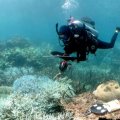In the face of impending climate change impacts coastal mangrove defence has been declining rapidly, while support for assessment of this valuable habitat has weakened, according to a panel of International experts at INTECOL 2009 in Brisbane this week.
(Intecol is the 10th International Conbgress of Ecology, being held until tomorrow, August 21).
The scientists called for a nationally coordinated effort in Australia to match programs in other countries to address the deteriorating condition of this frontline coastal defence from climate change. They cite the ever-growing reality that Australia’s mangroves are deteriorating rapidly in populated places where they are needed most.
The University of Queensland’s Dr Norm Duke who convened the forum, said that Australia, while having the second largest area of mangroves in the world, had no national strategy to manage its vast and valuable tidal wetland areas.
"It is embarrassing when compared with the notable and significant efforts applied in less developed countries nearby," he said.
"In Moreton Bay in South-East Queensland, up to 20 percent of bay mangroves have died in recent decades and degraded into sterile ponds without oxygen.
"The worrying concern is that few investigations have been initiated or supported by local managing agencies.
"There needs to be a greater appreciation of this emerging issue, and the serious implications of likely negative effects on local fisheries, marine life, and tourism."
Dr Duke said Australia needed mangroves not only for their immense fisheries benefits, but also for shoreline protection.
"Mangroves are the frontline defence and often the last defence – against anticipated rises in sea level and increased storm damage expected from climate change.
"They are the unsung indicators of upstream catchment health and coastal water condition.
"Mangroves are at greatest threat in areas where people are settled with strongly armoured coastlines of sea walls, dykes and other forms of defensive structures. Mangroves will be squeezed and extinguished against these defences as seas rise."
Dr Duke said polluted mangroves were weakened and less able to withstand the effects of severe storms.
Dr Ilka Feller, an international mangrove expert with the Smithsonian Institution said that in a mangrove site in Florida, he had measured more damage and slower recovery of nutrient enriched trees following severe hurricane damage.
"The situation has to change!’ Dr Duke said.
‘We need to support the natural mangrove buffers we have, before we depend on them to protect seaside property and inshore fisheries. Our consensus is that we need to buy time."
One innovative program that commenced earlier this year is MangroveWatch in the Burnett Mary Region of Queensland.
This Community Coastcare funded initiative with The University of Queensland has enlisted community and school groups to become custodians of local estuaries and shoreline. Over 16 river keeper groups will monitor more than 20 major estuaries and creeks in the region.
The unique program engages community members and science experts in the whole of region monitoring of ecosystem health of coastal estuaries.
Dr Duke said Australia needed to keep better watch over its mangroves.
"They are unique indicators of coastline health. Their condition tells us not only about healthy coastal and estuarine fisheries, but their health augers well for healthy offshore sea grass beds with turtles and dugongs, and healthy mangroves are end-of-catchment indicators of healthy upstream catchments."
Media: Dr Duke, telephone 07 3365 2729 or 07 3365 4333 or 0419 673 366.
.jpg)



